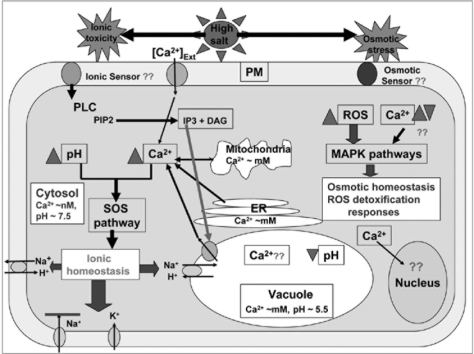Figure 1.
A proposed model of salt-stress tolerance in plants at cellular level. The sensing of ionic stress induces a transient elevation of cytosolic Ca2+ and pH.6,38,39,43 Cytosolic-Ca2+ elevation is attributed with the influx of Ca2+ from cell wall, as well as from the vacuole. ER and mitochondria may also contribute to cytosolic-Ca2+ elevation. The cytosolic-pH increase seems to be linked with vacuolar-pH decreases.38 Cytosolic Ca2+ elevation and pH increase, either independently or in coordination, induces the SOS pathway for ionic homeostasis through inhibition of Na+ entry, enhancing K+ uptake into the cell, and sequestration of cytosolic Na+ either into the apoplast or vacuole.24,34,55 Cell organelles, such as nucleus, mitochondria, ER etc., might also have their own Ca2+ elevation and subsequent signaling cascade for downstream responses.85,86 Osmotic stress, in contrast to ionic toxicity, may either decrease or increase cytosolic-Ca2+ level, which might be linked with the production of reactive oxygen species (ROS).52 ROS then activates the MAPK pathways for osmotic homeostasis and detoxification responses.

